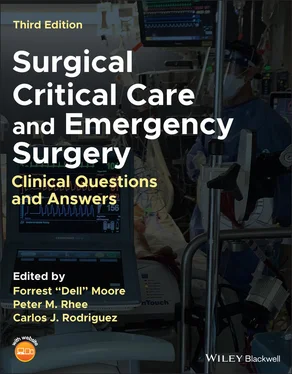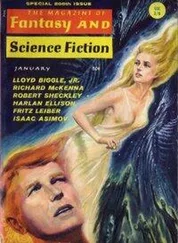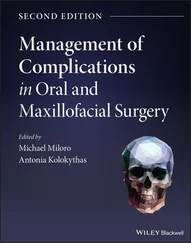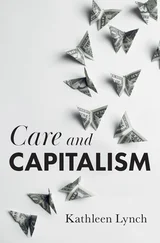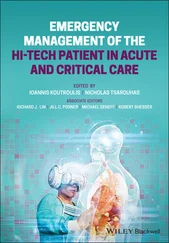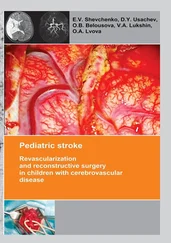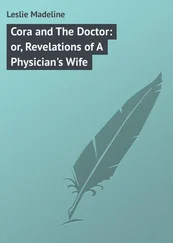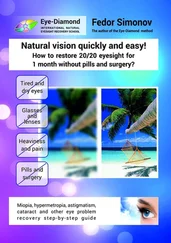Surgical Critical Care and Emergency Surgery
Здесь есть возможность читать онлайн «Surgical Critical Care and Emergency Surgery» — ознакомительный отрывок электронной книги совершенно бесплатно, а после прочтения отрывка купить полную версию. В некоторых случаях можно слушать аудио, скачать через торрент в формате fb2 и присутствует краткое содержание. Жанр: unrecognised, на английском языке. Описание произведения, (предисловие) а так же отзывы посетителей доступны на портале библиотеки ЛибКат.
- Название:Surgical Critical Care and Emergency Surgery
- Автор:
- Жанр:
- Год:неизвестен
- ISBN:нет данных
- Рейтинг книги:3 / 5. Голосов: 1
-
Избранное:Добавить в избранное
- Отзывы:
-
Ваша оценка:
- 60
- 1
- 2
- 3
- 4
- 5
Surgical Critical Care and Emergency Surgery: краткое содержание, описание и аннотация
Предлагаем к чтению аннотацию, описание, краткое содержание или предисловие (зависит от того, что написал сам автор книги «Surgical Critical Care and Emergency Surgery»). Если вы не нашли необходимую информацию о книге — напишите в комментариях, мы постараемся отыскать её.
Surgical Critical Care and Emergency Surgery Surgical Critical Care and Emergency Surgery,
Surgical Critical Care and Emergency Surgery
Surgical Critical Care and Emergency Surgery — читать онлайн ознакомительный отрывок
Ниже представлен текст книги, разбитый по страницам. Система сохранения места последней прочитанной страницы, позволяет с удобством читать онлайн бесплатно книгу «Surgical Critical Care and Emergency Surgery», без необходимости каждый раз заново искать на чём Вы остановились. Поставьте закладку, и сможете в любой момент перейти на страницу, на которой закончили чтение.
Интервал:
Закладка:
2 Cardiopulmonary Resuscitation, Oxygen Delivery and Shock
Kevin W. Cahill, MD, Harsh Desai, MD, and Luis Cardenas, DO, PhD
Department of Surgery, Christiana Care Health Care System, Newark, DE, USA
1 A 72‐year‐old woman with a history of Child’s B cirrhosis and supraventricular tachycardia is in the ICU following laparotomy for strangulated ventral hernia. She begins to complain of rapid heartbeat and is noted to be in an irregular, wide‐complex ventricular tachycardia on EKG. She maintains pulse and adequate blood pressure. Which of the following is the best initial therapy to administer?Synchronized cardioversion.Adenosine 6 mg IV.Amiodarone 150 mg IV.Defibrillation.Vagal maneuvers.The 2020 ACLS guidelines differentiate between regular and irregular wide‐complex tachycardia with and without pulse. In this instance, the patient is in an irregular wide‐complex tachycardia, symptomatic, but stable as evidence by pulse and pressure. Given this hemodynamic stability, synchronized cardioversion and defibrillation are not the initial therapies (choices A, D). Adenosine and vagal maneuvers may be effective in regular ventricular tachycardia (choices B, E). Therefore, amiodarone is the best initial medication to administration often followed by infusion (choice C). Individuals with hemodynamically unstable ventricular tachycardia should not initially receive amiodarone. These individuals should be cardioverted. Amiodarone can be used regardless of the individual's underlying heart function and the type of ventricular tachycardia. It can be used in individuals with monomorphic ventricular tachycardia, but is contraindicated in individuals with polymorphic ventricular tachycardia as it is associated with prolonged QT intervals, which will be made worse with anti‐arrhythmic drugs. Amiodarone is categorized as a class III anti‐arrhythmic agent, and prolongs phase 3 of the cardiac action potential. Amiodarone slows conduction rate and prolongs the refractory period of the SA and AV nodes. It also prolongs the refractory periods of the ventricles, bundles of His, and the Purkinje fibers without exhibiting any effects on the conduction rate. Serious side effects include interstitial lung disease and liver dysfunction with elevated liver enzymes.Answer: CLittmann L, Olson EG, Gibbs MA . Initial evaluation and management of wide‐complex tachycardia: a simplified and practical approach. Am J Emerg Med. 2019; 37: 1340–1345.Panchal AR, Bartos JA, Cabanas JG et al. Part 3: Adult basic and advanced cardiac life support: 2020 American Heart Association guidelines for cardiopulmonary resuscitation and emergency cardiovascular care. Circulation. 2020; 142 (suppl 2): S366–S468.
2 Which of the following techniques has not been shown to be effective in airway management during cardiac arrest?Head tilt – chin liftJaw thrustCricoid pressureNasopharyngeal airwayOropharyngeal airwayOf the above maneuvers, cricoid pressure has not been shown to be effective during airway management in cardiopulmonary resuscitation. It may impede ventilation or placement of airway adjuncts such as a supraglottic airway as well as contribute to increased airway trauma. Jaw thrust is preferred in patients with suspected spinal injury. Nasopharyngeal and oropharyngeal airways are particularly useful in cases of facial trauma though care must be taken with possible basilar skull fractures.Answer: CCarauna E, Chevret S, Pirracchio R . Effect of cricoid pressure on laryngeal view during prehospital tracheal intubation: a propensity‐based analysis. Emerg Med J. 2017; 34 (3): 132–137.Panchal AR, Bartos JA, Cabanas JG et al. Part 3: Adult basic and advanced cardiac life support: 2020 American Heart Association guidelines for cardiopulmonary resuscitation and emergency cardiovascular care. Circulation. 2020; 142 (suppl 2): S366–S468.
3 In a patient experiencing PEA arrest, which of the following would not be a likely etiology?HypoglycemiaHypoxiaHypovolemiaHypokalemiaHypocalcemiaPulseless electrical activity is so named due to evidence of cardiac mechanical activity on echocardiogram or rhythm on EKG. The algorithm is similar to the asystole algorithm utilizing compressions and epinephrine. The traditional etiologies are described as “Hs” and “Ts.” The “Hs” include hypoglycemia, hypoxia, hyper/hypokalemia, hypovolemia, acidosis, and hypothermia. Hypocalcemia can present with muscular and neurologic symptoms such as perioral numbness, cramping, fatigue, seizures, and irritability. Hypocalcemia may also be associated with increased risk of arrhythmias, but is not typically considered high on the initial differential of PEA arrest. The “Ts” taught as etiologies include tension pneumothorax, cardiac tamponade, toxins, pulmonary thrombosis, or coronary thrombosis. Evaluation for pneumothorax or tamponade includes rapid bedside physical exam as well as point of care ultrasound for rule out. Ultrasound may also reveal signs of thrombosis with right ventricular enlargement or free‐floating thrombus.Answer: EAndersen LW, Holmberg MJ, Berg KM et al. In hospital cardiac arrest: a review. JAMA. 2019; 321 (12): 1200–1210.Panchal AR, Bartos JA, Cabanas JG et al. Part 3: Adult basic and advanced cardiac life support: 2020 American Heart Association guidelines for cardiopulmonary resuscitation and emergency cardiovascular care. Circulation. 2020; 142 (suppl 2): S366–S468.
4 Which of the following is the minimum chest compression fraction (defined as amount of time spent delivering chest compressions during CPR) shown to be associated with improved survival?0–20%21–40%41–60%61–80%81–100%Optimal outcomes have been demonstrated with minimal pauses between compressions for pulse checks and breaths given during high‐quality CPR. A compression fraction of at least 60% has been shown to be necessary for best outcomes. Animal studies previously conducted have demonstrated decreased coronary and cerebral perfusion when chest compressions are not being conducted resulting in worsened outcomes. Multiple retrospective analyses and cohort studies have resulted in many emergency agencies targeting a compression fraction of between 60 and 80% as a quality metric. This involves delivery of high‐quality compressions of appropriate depth, 2 inches, and rate, at least 100/min.Answer: DChristenson J, Andrusiek D, Everson‐Stewart S et al. Chest compression fraction determines survival in patients with out of hospital ventricular fibrillation. Circulation. 2009; 120: 1241–1247.Panchal AR, Bartos JA, Cabanas JG et al. Part 3: Adult basic and advanced cardiac life support: 2020 American Heart Association guidelines for cardiopulmonary resuscitation and emergency cardiovascular care. Circulation. 2020; 142 (suppl 2): S366–S468.
5 Which of the following is considered the highest predictor of survival for in‐ and out‐of‐hospital CPR?Age.Shockable rhythm.Arrest at home.Arrest at night vs during the day.Delayed EMS response time.On the whole, survivability is dependent on patient, system, event, and therapeutic factors. With increasing comorbidity and age, survivability decreases. System factors include time to arrival of EMS, time to initiation of CPR, and time to defibrillation. Event factors include preceding symptoms. Finally, therapeutic factors include availability of medications to treat suspected cause, time to ER, time to cath lab should it be required, etc. The greatest mortality risk with out of hospital cardiac arrest stems from unwitnessed arrests without bystander CPR often occurring at night in the elderly. Highest survivability stems from witnessed arrests with rapid initiation of bystander CPR and initial shockable rhythm, such as ventricular fibrillation.Answer: BMyat A, Song K‐J, Rea T . Out of hospital cardiac arrest: current concepts. Lancet. 2018; 391: 970–79.Navab E, Esmaelli M, Poorkhorshidi N et al. Predictors of out of hospital cardiac arrest outcomes in pre‐hospital settings; a retrospective cross‐sectional study. Arch Am Emerg Med. 2019; 7 (1): e36.
Читать дальшеИнтервал:
Закладка:
Похожие книги на «Surgical Critical Care and Emergency Surgery»
Представляем Вашему вниманию похожие книги на «Surgical Critical Care and Emergency Surgery» списком для выбора. Мы отобрали схожую по названию и смыслу литературу в надежде предоставить читателям больше вариантов отыскать новые, интересные, ещё непрочитанные произведения.
Обсуждение, отзывы о книге «Surgical Critical Care and Emergency Surgery» и просто собственные мнения читателей. Оставьте ваши комментарии, напишите, что Вы думаете о произведении, его смысле или главных героях. Укажите что конкретно понравилось, а что нет, и почему Вы так считаете.
